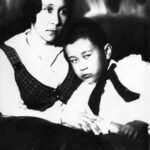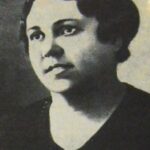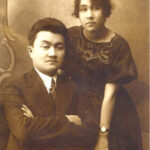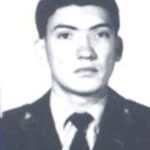Alikhan Bukeikhanov
The wife of Alikhan Bukeikhanov – Elena Yakovlevna Sevostyanova
(Year of birth is unknown – 1921)
Alikhan Bukeikhanov married to Elena Yakovlevna Sevostyanova in 1901 (according to some sources in 1902) in Omsk. Elena Yakovlevna is a daughter of a descendant of settlers in Siberia, exiled leader of the popular movement Yakov Sergeevich Sevostyanov, whom Alikhan met during the period of work of the West Siberian Department of the Imperial Russian Geographical Society and in the editorial office of the Omsk non-governmental newspaper “Stepnoy edge”, distinguished by a fair amount of free-thinking. Their views on life and politics brought them closer together.
According to the recollections of Srym, Alikhan Bukeikhanov’s nephew, Yakov Sevostyanov did not interfere with Alikhan’s acquaintance with his daughter. When the young people came for a blessing for the marriage, he said: “Daughter! I would never wish you a better chosen one than Alikhan. But both of you must be prepared for difficulties. He is Kazakh and grew up among the steppe people with their conventions and traditions. You’re Russian. They will blame him for choosing the Russian one. You will often be reproached by your fellow tribesmen that your husband is a foreigner. I bless you. But be patient and let love keep you.”
It should be noted that Sevostyanova has never been to Kazakhstan. But she let go of the children willingly. Bukeikhanov had two children from her – a daughter and a son. Daughter Zeynep, according to some information Kanipa (according to the passport Elizabeth) was born in 1902 in Omsk, the son Oktay (Ugedei, according to the passport Sergey) was born in 1904 in St. Petersburg.
Elena Yakovlevna Sevostyanova died in 1921 from an illness.
The daughter of Alikhan Bukeikhanov – Zeynep (Elizabeth) (1902-1971)
Zeynep (according to other information Kanipa) is the daughter of Alikhan Bukeikhanov. Daughter Elizabeth was born in 1902 (according to some sources in 1903) in Omsk. Later, during her life in Moscow, upon reaching adulthood and upon receiving a Soviet passport, Zeynep received a second name and became Elizabeth, whom her father affectionately called “Lizazhan” in letters to his comrades-in-arms.
All childhood and adolescence of Liza and Oktay passed alongside their parents, sharing with them all the hardships and deprivations of the father’s political struggle against the tsarist autocracy, and then against the Soviet regime. From about 1903 to 1905, the family of the leader Alash spent in St. Petersburg, when Lisa was only a year old, and where his younger brother Oktay was born in 1904. Liza returned to her native Omsk at the end of 1905 with her family due to the fact that her father decided to run for the First State Duma from the Kazakh population of the Semipalatinsk region. It was after returning to Omsk that she first felt the danger posed by the political activities of her father, who fought for the rights and freedom of the multimillion Kazakh people. On December 1908 after her release from the Semipalatinsk prison, Liza and her family stayed for a short time again in St. Petersburg, and in February-March 1909 the whole family moved to Samara. Liza went to primary school in Samara. However, her life was full of fears and anxious expectations in Samara. The tsarist secret police established external surveillance behind their house. In addition, my father often went on business trips. At the end of 1916, Lisa saw her father’s telegram, where he reported that he was on … the line of the Western Front of World War I near Minsk, which horrified the whole family… Then, after the February Revolution of 1917, my father received a high position from the new Provisional Government and ended up in Orenburg. Ultimately, Lisa saw her father only in March-April 1918, that is, more than 2 years later. But not in Samara, but in the city of “Alash” (the former village of Zarechnaya Slobodka near Semipalatinsk), which was elected by the December All-Kazakh Kurultai (II All-Kazakh Congress) as the location – the capital of the Provisional All-Kazakh Council “Alash Orda” – the government of Alash Autonomy. After the accession of Autonomy Alash to Soviet power, Liza, who had already graduated from school in 1920 and 1922, became an unwitting witness of how her father was in Soviet prisons – also without trial or investigation. In October 1921, mother Elena Yakovlevna died untimely from illness in Semipalatinsk. After the arrest of his father in November 1922, in Karkaraly, Alikhan Bukeikhan was forcibly taken first to Orenburg, and then to Moscow, where he was provided with work and housing in a communal apartment. Soon Lisa and Oktay moved to their father.
In 1923, Elizabeth married one of the youngest and brightest leaders of the Government of Kazakhstan in the 30s – Smagul Sadvakasov (1900-1931). The wedding took place in the village of Zharkyn in the homeland of Smagul Sadvakasov. A fellow countryman and friend of the groom, the talented Magzhan Zhumabaev recited poetry at their wedding. In 1927 Lisa graduated from the medical faculty of the 1st Moscow State University. After political persecution, Smagul Sadvakasov was forced to leave Kazakhstan, he was sent to the construction of the Moscow-Donbass railway. According to official data, in the fall of 1933 in Voronezh, Smagul Sadvakasov fell ill with typhoid fever; on December 16 of the same year, at the age of 33, he died in a Moscow hospital. But until her death, Elizabeth Alikhanovna was convinced that Smagul Sadvakasov had become “a victim of atrocity by the repressive organs”.
His body was cremated; Alikhan Bukeikhan, Liza Alikhanovna, as well as the novice “proletarian writer” Sabit Mukanov with his wife Mariyam participated in the funeral.
Lisa remembered how she survived the terrible 30s. “Father,” she said, “knew that sooner or later they would come for him. Therefore, he prepared me in advance for these events. He warned that in the event of the most difficult trials, a very famous person, a prominent scientist, will help me. “And indeed, when the arrest occurred, the financial and psychological assistance to the young woman was most likely provided by Academician Sergei Oldenburg (at that time the names were not indicated). So, the days passed in agonizing anticipation. Lisa completed her residency studies in Moscow.
In July-August 1937, an order was issued signed by the People’s Commissar of Internal Affairs of the USSR, General Commissar of State Security Nikolai Yezhov. This little-studied order is called “Operational Order of the PCIA No. 00486”. This “Operational Order”, ominous and terrible in its consequences, established the procedure for the arrest and conviction of the MFTM (a member of the family of traitors to the Motherland) for 5 years and the placement of their children in orphanages. Children over 15 years old were recognized as “socially dangerous” and were subject to mandatory arrest. Researcher Gulnar Mukanova gave a very interesting message that A. Bukeikhan’s daughter was in “ALZHIR” (Akmola camp of wives of traitors of motherland) camp at number 562 and was listed as “Ukrainian – Elizabeth Alikhanovna Sadvakasova”. According to some reports, in relation to Liza Alikhanovna, the norms of the terrible order No. 00486 of August 15, 1937 were not applied. Only some miracle saved Liza Alikhanovna and Eskendir Smagulov from these terrible and inhuman orders. Most likely, the role was played by the fact that Alikhan Bukeikhan was arrested as a “Kazakh nationalist”, and Elizabeth Alikhanovna and her son lived in Moscow and somehow fell out of sight of the chekists.
Liza Alikhanovna went a long way of wandering with her father. Her father, Liza and son Yeskendir Smagulov settled in a one-room communal apartment in Moscow. This apartment was the place where Lisa and her father settled in the twenties. “Here she spent her youth, here she married Smagul, not far from this house, in Grauerman’s maternity hospital, she gave birth to Kenka (Yeskendir), from here her father was taken in 37th to Butyrka”… “Kenka fled from here to the militia and did not return; from here she went to the front and then returned here with the rank of major. Here she became a professor and a very famous person in medical circles”. This apartment was located at 4 Semashko Street and “many events took place in it, which from the standpoint of today were historical”.
With the beginning of the Great Patriotic War Liza Alikhanovna went to the front (a military doctor of the 3rd rank, in 1945 she was demobilized with the rank of major of the medical service, was awarded orders and medals). She went through the war as a doctor. She saved lives of people. The war did not save her Kenu. The early matured only son Yeskendir, being a 16-year-old teenager, assuring him that he had already turned 18, achieved sending to the front, disappeared in action near the village of Skirmanovo in the Novo-Petrovsky district of the Moscow region. After the war, Elizabeth Sadvakasova searched for her son or at least his grave for a long time, but she never found it. The stigma of “daughter of an enemy of the people”, “daughter of a nationalist” haunted her all her life. Perhaps that is why she could not come to Kazakhstan, since there were enough Stalinists here and she could well have been subjected to the cruelest and sophisticated persecutions.
After the war, Elizabeth Alikhanovna worked at the central scientific and methodological bureau of sanitary statistics of the USSR People’s Commissariat for Health. From 1945 to 1948 she was the scientific secretary of the All-Russian Research Institute of Social Hygiene and Health Organization named after N.A.Semashko, and from 1959 to 1969 she headed the department of sanitary statistics of this institute. The last place of work of E.A. Sadvakasova was the Central Institute for Advanced Medical Studies. Throughout her creative scientific life (she has published more than 50 scientific articles) E.A. Sadvakasova dealt with the theory and methodology of sanitary-statistical research. She retained her sanity even when loved ones died untimely: first, in 1921, mother Elena Yakovlevna Sevostyanova from illness, then under mysterious circumstances her beloved husband Smagul (1933), father Alikhan was shot (1937), disappeared without a trace at the fronts of the Great Patriotic War dear “Kena”, son of Iskander (Yeskendir).
In 1965, she defended her doctoral dissertation, which formed the basis for the monograph “Social and Hygienic Aspects of Family Size Regulation” published in 1969, which has become a classic research in medical science. For a long time this monograph remained the only work of its kind. The monograph by Elizabeth Alikhanovna contains the results of a long-term (about 30 years) study of the selected problem, including abroad (Western Europe, the USA and Japan; countries of Latin America, Asia and Africa, as well as countries of Central and Eastern Europe) and in pre-revolutionary Russia and USSR according to literary sources, according to the results of our own statistical research.
In recent years, Liza Alikhanovna began to get tired often. She still lived in an old communal apartment, adjusting to the mood of her neighbors in the communal apartment. Two elderly people, war and labor veterans, a famous scientist, she lost her father, husband and son during the war and with her second husband Max Natanovich Kleinman (1891-1996), deputy director of the Institute of Motherhood and Infancy, deputy head of the department of the Ministry of Health, was forced to live in the poorest conditions. And only the memory of close people who once closely surrounded and loved her, kept her. Later, in the 70s, they bought a two-room apartment in a new high-rise building on Vernadsky Avenue, quite far from the center.
Syrym Bukeikhanov, the grand-nephew of Alikhan Bukeikhanov, recalls: “Aunt Liza began to fade away quickly. She was taken to Izmailovo, in the Kremlin hospital. She had a cancer. I began to lose weight and did not eat anything. The body began to reject everything. It was a terrible grief for me … It was always good for me to be around her. Probably because my mother passed away early, and by nature, I needed more maternal kindness, affection, and understanding. And she was leaving this life”. In mid-July, Alexandra (Sasha) Bukeikhanova, Syrym’s wife, wrote a letter to Almaty: “Hello, Raimzhan Azizkhanovich! I won’t write anything good, so get ready … Aunt Liza grew weak. More everything lies. It only turns out to sit on the street for two hours. Chemistry has absolutely no effect on it, and it can be pumped out at home. A sister goes to her house, gives her injections – one cardiac, the other inhibiting the growth of a tumor. Aunt Liza understands these psychological techniques. He prepares himself for the fact that when he finally has to sleep, he will have to take poison”. Syrym Bukeikhanov flew to Moscow. “I hadn’t seen my aunt for several months and was immediately horrified when I entered the ward. The once-blooming woman, who was far from thin, looked like an anatomical skeleton covered with skin. I sat down next to her bed and held her by the thin brushes, pricked by needles. She silently looked at me … I lifted Aunt Lisa in my arms and held her like a child. When I gently laid her back on the bed, she began to speak to me hysterically, with difficulty squeezing out the words: “My father gave me a heart that saved me before, but now does not allow me to die in peace”. She kept asking me to wash her face with cold water. It is possible that she often recalled Siberia, Semey, the endless Kazakh steppes, which her father told her with love, where she once lived and, probably, was happy. This is how the daughter of the great son of the Kazakhs Alikhan Bukeikhan was died. Liza Alikhanovna died on the night of June 21-22, 1971.
Syrym Bukeikhanov continues: “To die of starvation, in agony, was the last test of this courageous man. Few of my relatives had such a fate: to live with the stigma – “the daughter of an enemy of the people”, to lose early husband and only son, to constantly prove their worth in life and to die such a terrible death”. After her cremation, the question of her burial was decided for a long time. Colleagues have achieved the decision of the Moscow City Executive Committee to place the urn at the Novodevichy cemetery, in the wall. (She buried with M.N. Kleinman in the columbarium of the Novodevichy cemetery (section 135, 68-3)).
The name of Elizabeth (Zeynep) Bukeikhanova is included in the weekly catalog “Demoskop” published by the Open Society Institute of the Soros Foundation and timed to coincide with the 95th anniversary of the outstanding scientist (S. Mukanov). Unfortunately, in Kazakhstan there are no memorial signs that would remind of this beautiful and proud woman.
The son of Alikhan Bukeikhanov – Sergey (1904–1957)
Son Oktay (Ugedei, Sergei) was born in 1904 in St. Petersburg. Upon reaching adulthood and upon receiving a Soviet passport, Oktay received a second name – Sergei.
Sergey is a graduate of the Geological Exploration Department of the Moscow Mining Institute. His activities are associated with Zhezkazgan. Oktay Bukeikhanov was a mining engineer by profession. He started working in about 1929 and became the author of a serious scientific work on the prospects of Zhezkazgan. Kanysh Satpayev in his numerous works on Zhezkazgan points to his colleague in the exploration department of the Karsakpay combine Sergey Bukeikhanov: “Bukeikhanov, whom everyone called Sergei Alikhanovich, settled with us,” recalls my mother, Doctor of Medicine, Professor Khanisa Satpayeva. – Our family lived in a small house, in one half of which there was a geological prospecting office, and in the other half we. When Sergei Alikhanovich got married, we made room and vacated one of our three rooms for the newlyweds. Later, the plant management provided the young family with new housing”.
Fate dealt with him pretty cool. He was arrested after his father and ended up in Norilsk. “But one day, during the war winter of 1941/1942, he showed up. Some military men accompanied him. Sergei said that he was taken on a special flight to Moscow and tomorrow he is going to the Kremlin for an appointment. And so it happened, but how the conversation ended at a high level, Sergei did not tell. He mysteriously disappeared. And only many years after the war, he said in great secrecy that he worked in the Urals as the director of a uranium mine in the department of the all-powerful Lavrentiy Beria, as he was considered a good specialist in rare minerals. His life path was not completely outlined until his death in the mid-fifties of the twentieth century”, recalls Khabylsayat Azimbaevich Abishev, a well-known Kazakh Bukeikhanov scholar.
Then he lived in the city of Sorsk in the Khakass Autonomous Region, where he worked as a chief engineer in a geological exploration expedition. There he died in December 1957, leaving behind scientific works on copper and uranium ores.
According to the testimony of Syrym Bukeikhanov’s grand-nephew (the son of Raimzhan, the grandson of Ezikhan, Alikhan’s younger brother, was left without a mother early, was brought up by Elizabeth Bukeikhanova-Sadvakasova), Sergei had a son, Eugene, and Eugene’s son, Peter, lives in Moscow.
The well-known researcher of the life and work of Alikhan Bukeikhanov, Sultan Khan Akkuly, reports that Alikhan’s grandson, Eugene Sergeevich Bukeikhanov, became a candidate of technical sciences, his son Peter Eugenevich Bukeikhanov, a great-grandson, defended his dissertation of a candidate of legal sciences.
According to D.A. Kunaev, he knew the son of the leader Alash from his work. “From Alikhan, there is a son named Oktay (in Russian transcription Ugedei)”, said the former communist leader of Kazakhstan. – We talked to the descendant of the leader of the nation for work. Outwardly, he was dark-skinned, which was very reminiscent of his father, strong-built, incredibly hardy. He was a geologist by profession. At one time, along with Kanysh Satpayev, he made a significant contribution to the development of the Zhezkazgan deposit. A year before the rehabilitation of Alikhan’s father, he died on the land of Karelia, where he lived. He buried there. I remember the words of Kanysh (Satpayev), expressed by him with regret: “He was a descendant of a great personality. He was not destined to find eternal peace on the Kazakh land too. “So there is also a descendant from Oktay. As Khaydar Ayrystanbek told me, he seems to live in Moscow. In general, according to the rumors that reached me, this uncle was in close contact with the descendants of Zhakyp (Akbayuly – Akpaev) and Alikhan …”
Grandson of Alikhan Bukeikhanov – Iskander Smagulovich Sadvakassov (1924 – 1941)
Iskander(Kenka) Smagulovich Sadvakassov is the son of Elizabeth Alikhanovna. The only son Iskander, who matured early, being a 16-year-old teenager, assuring him that he had already turned 18, managed to be sent to the front, disappeared in action near the village of Skirmanovo, Novo-Petrovsky district, and Moscow region. After the war, Elizabeth Sadvakassova searched for her son or at least his grave for a long time, but she never found it.
Grandson of Alikhan Bukeikhanov – Eugene Sergeievich Bukeikhanov (1938)
Eugene is the son of Sergei Bukeikhanov, the grandson of Alikhan Bukeikhanov. He was born into a family of geologists in the Urals on October 26, 1938. Since 1949 in Moscow, he received his secondary education and graduated from two institutes: the Moscow State Pedagogical Institute (Faculty of History and Philology) in 1960 and the Moscow Institute of Communications in 1971 (evening faculty).
In the interval between the two institutes he served military service in the Soviet Army. After graduating from the second institute, he entered graduate school and, after defending his thesis, worked as a teacher at the Department of Automatic Telecommunications of the Moscow Electro technical Institute of Communications, candidate of technical sciences, later an employee of one of the companies at the Moscow University of Communications and Informatics.
In 1992 after visiting Kazakhstan, where he was invited to the 125th anniversary of his grandfather Alikhan, he really began to write poetry.
Here he has khown what the spirit of the ancestors is – aruakh (ancestral spirit), as (memorial dinner), baiga (horse racing), memorial prayer and much more. He writes: “My relatives invited me to Aktogay to celebrate the 125th anniversary of Alikhan Bukeikhanov. The celebration lasted only a few days, but it made a stunning impression on my son Peter (born March 9, 1970) and me. The first meeting with the steppe on the way from Karaganda to Aktogay, meeting with relatives, visiting the motherland of my grandfather in Karatal – all this fell in a flurry of feelings and thoughts. I was struck and deeply touched by the love of my relatives, whom I had never seen before and who loved us not for any merits, but simply because we were alive and came to them. I realized that my grandfather belongs not only to me, but to all the people.
On the eve of the holiday, my relative Kasenkhan Altynbekov fell seriously ill, who wanted to see me and was hospitalized before my arrival. When we visited him in the hospital, he barely inaudibly said, looking into my eyes: “We are proud, but simple. There are beautiful boulevards and girls in Moscow, but don’t forget about us …” I stood holding his hand in mine, and he, dying, as if bequeathed to me to love the native land of my ancestors.
Under the influx of all these impressions, I decided that the best response on my part to such feelings of my relatives would be to try to express in verse everything that I felt and experienced. These verses express my gratitude to everyone who helped me to see and feel the Steppe – the land of my ancestors, to hear the call of the past from the depths of the centuries, to see my relatives”.
Author of the books “To touch this strange world”, “Date with the Steppe”.
Great-grandson of Alikhan Bukeikhanov – Peter Eugenevich Bukeikhanov (1970)
Peter Eugenevich Bukeikhanov is the great-grandson of Alikhan Bukeikhanov, the son of Eugene Bukeikhanov. He was born on March 9, 1970. In 1992 he graduated from the Moscow Institute of Energy and became a specialist in nuclear energy. He is a candidate of legal sciences and a retired colonel. Petr Eugenevich has a daughter, Daria, born in 2009. He published works: “How Peter I pacified Europe and Ukraine”, “Battle of Kursk. Operation “Kutuzov””, “The Kursk battle that we started”, “The Kursk battle. Defense. Operation “Citadel””.
Internet resources:
https://goo.edu.kz/content/view/161/20419?lang=ru&version=normal
https://kargoo.kz/content/view/46/321319600&lang=ru?lang=ru
http://inkaraganda.kz/articles/140564
http://www.demoscope.ru/weekly/2018/0775/nauka03.php
http://www.exclusive.kz/expertiza/obshhestvo/116973/
http://inkaraganda.kz/articles/141126
http://zhurnal-prostor.kz/assets/files/2016/2016-10/10-2016-09.pdf









